Battling frozen fuel, unpredictable storms and waist high snow; Arctic adventures can be trying at times. However, a British approach to tea breaks, and an eye for the beauty abound, can reward even the weariest explorer.
The Lesser of Two Evils
It was only day three of my two-week expedition and I had just spent the night shivering with the mercury below -35oC, in a partially collapsed down sleeping bag. My head throbbed from the cold, with perhaps a touch of dehydration contributing, and I have to admit that my normally sunny disposition was severely eroded. Faced with further nights in such unforgiving conditions, it was time to put on my thinking cap and evaluate my options. I fired up my Garmin GPS unit, one of the only pieces of electrical equipment that was still working at these temperatures, and clicked past on-screen messages complaining about the cold and how it was below its minimum operating temperature (I could sympathise). I studied the map of the area and discovered that there was a summer cabin, usually equipped with some form of emergency winter room, shown not too far from my position.
At this point I was suffering, not just from the cold, but with an internal battle in my head. Two days into a two week expedition, and faced with further nights of these sort of Arctic winter temperatures with a collapsed down bag, it would be surely fool hardy to continue as is. But, seeking the help of an emergency shelter to dry equipment, so soon into an intendedly unsupported expedition, would be quite the salt in the tea. With so many months in the planning, albeit with a slightly milder goal in Hardangervidda until just a month ago, I felt very silly to be considering heading to the shelter. It felt like failure, to be honest.
“At this point I was suffering”
I contacted my expedition manager, Alexandra, via my Garmin satellite communicator and discussed the problem. We of course reached the inevitable conclusion that it would be unsafe to continue with an ineffective sleeping bag, and these things don´t solve themselves, and that I should head to the hut to dry out my equipment. While this would lose me a whole day of expedition time, putting my tight schedule in jeopardy, I had to put my safety first. Afterall, it is always better to live to fight another day; Sarek wasn´t going anywhere soon and I had no desire to emulate the questionable heroics of Captain Scott. So, after a solemn breakfast of chocolate porridge, I trudged off to the mountain hut, disheartened, with my faithful pulk following me, unjudging.
Once at the mostly locked down hut, I hung out all my damp equipment in the emergency shelter room and got a fire going, before heading to the woodshed to play lumberjack and chop a day´s supply of fast burning birch for myself. After attending to the large blisters that had already formed on my right foot, I spent the day warming my extremities and equipment by the fire, while going through all the possible route permutations, assuming various daily speeds. It was clear that with my slower daily speed as a result of my worsening foot and the deep snow, combined with the present day lost to fire gazing, it would be difficult to even achieve my shortest route option. I had two days contingency and against all temptation, I kept these as contingency and didn´t include in my planned days. They are there for safety (and making the return flight), after all. Nevertheless, I would only do the best that I could and go for it.
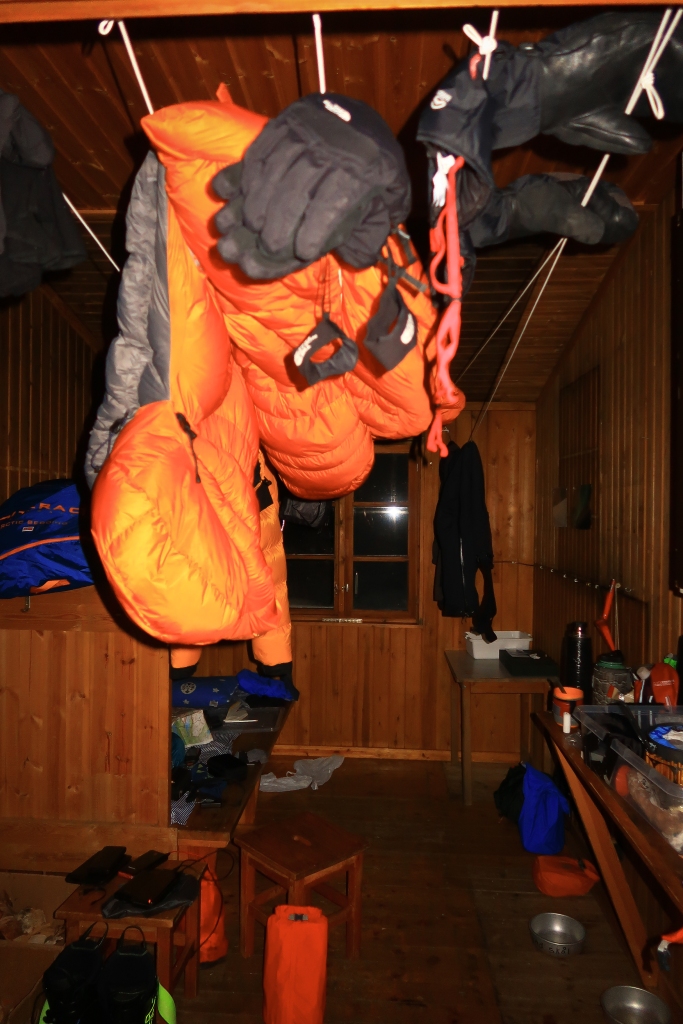
At some point during the day there was a surprise knock at the door; I opened it to find an inquisitive smile and eyes with decades of experience behind them. Here stood Paul, and this was my first encounter with him on the trip, though it wouldn´t be my last. Despite his British sounding name, Paul was a Swede doing a similar solo pulk expedition as me, although he was spending a whole month in the area, with no particular plan or route. He had recently quit his job, and his wife, clearly fed up with him getting under her feet, kicked him out into the wilderness for a month of solitude. He had been doing this sort of thing for the best part of forty years, even without matrimonial encouragement, some of which with the Swedish military. This was a man who really knew what he was doing.
He had been drawn to the hut by the rising column of smoke, wondering who else might be mad enough to be exploring Sarek in February. We swapped tales for a few minutes and I of course picked his brains for the latest lowdown on the area; with the mountain stations closed for the winter, info was hard to come by. The snow was unseasonably deep here, he said, because the strong westerly winds had blown it all from the west side of the park to the east. He remarked that my wide powder skis were exactly the sort of thing he needed right now, in these conditions. I replied, feeling the throb of open blisters in my foot, that plastic alpine touring boots were certainly not what he would want, especially for a month.
Light humour dispensed with, he warned me of the dangers of the Rapa river, further along my route. The surface of the river freezes early in the year but the water level continues to drop as the glaciers withhold their lifeblood in the winter. This leaves perilous areas where the river ice can be as high as one metre above the actual river; a real danger of falling through for anyone crossing. It would be better that I go further east, across the Tjaktjajavrre lake, and go up the Rapa by its east shore. This would mean more kilometres on the route, and more tricky terrain though the trees, but a clear necessity given the risk. Before leaving to continue his journey, he remarked that it had been incredibly cold last night. With my collapsed down bag, I couldn´t agree more; Paul had of course been using a vapour barrier liner in his bag, given the expected conditions. This was a big learning for the next trip, and one that I would not forget in a hurry. Interestingly, the scale on Paul´s thermometer went down to -35oC, 5 degrees below mine, and even his had gone right off the scale! With temperatures well below -35oC, it was clear that the Arctic in winter was not to be trifled with.
“It was clear that the Arctic in winter was not to be trifled with”
I spent the rest of the day ensuring all my gear was ready to go the next day, and in the evening I treated myself to some light entertainment. I had taken the liberty of downloading a few films onto my phone, in case I had a quiet evening, though to be honest I hadn’t really pictured it happening in this particular way. With a soothing freeze dried meal of chicken korma with added spice, I settled down to watch a horror film about four hikers who get lost in the woods of Sarek National Park and end up finding a strange and spooky hut, in which starts their inevitable torment and bloody demise. One should always keep these things topical, if at all possible.
What Comes from the West
Following a somewhat improved night’s sleep, at least as good as one can get in a sagging bed that is a foot too short, I set off with high spirits and a spring in my step. In the morning I followed the remains of a snowmobile track, likely from one of the park rangers, and made good progress across the alternating lakes and woods. Adjusting my tea breaks to being shorter and more frequent, as I suppose a British gentleman should, I found that my temperature management at such stops was markedly improved on the previous days. However, I am not entirely sure whether tea and biltong will replace the more traditional convention of tea and cake.
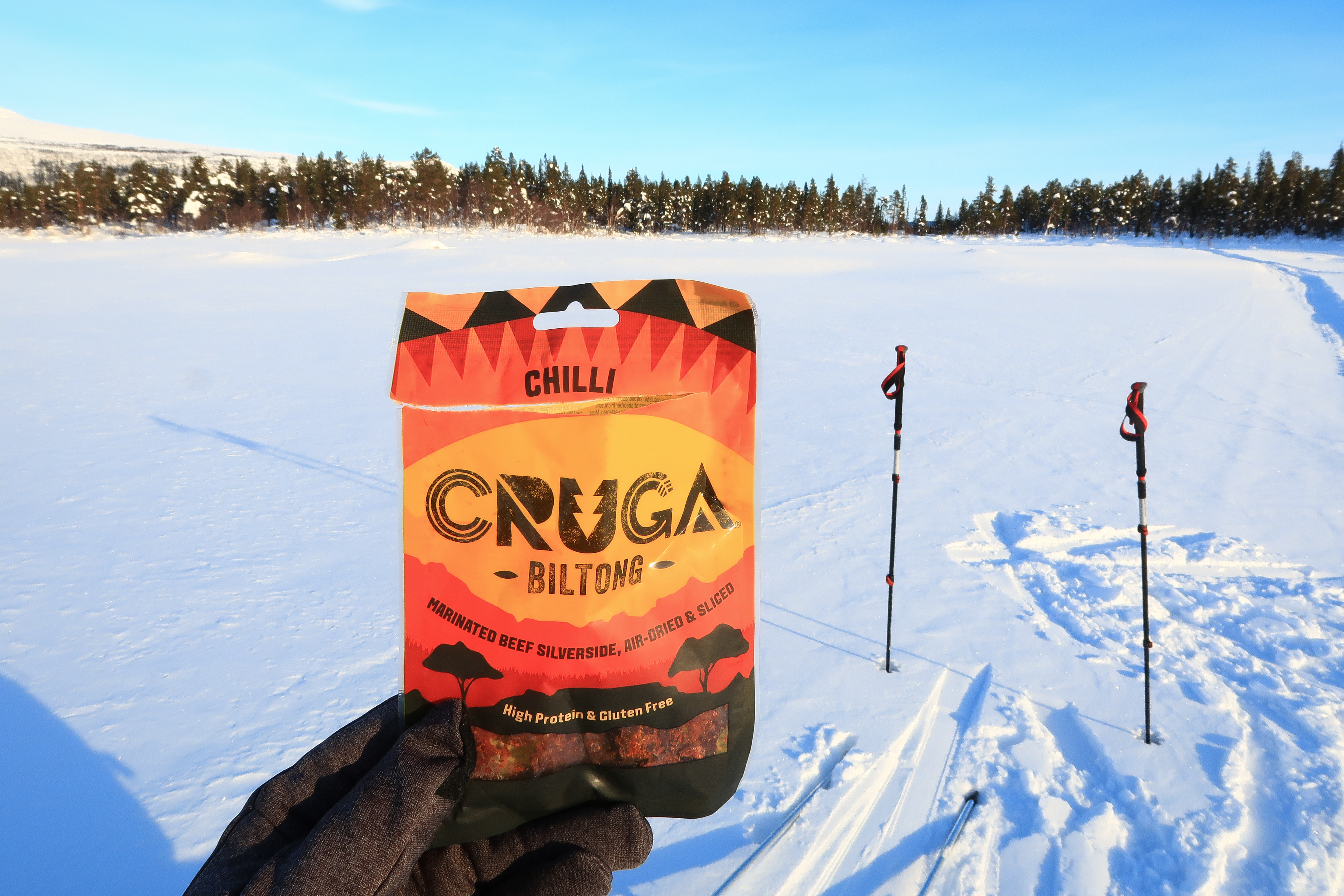
Speaking of biltong; food choice on such an expedition is something that takes a little tuning, even compared to trips in milder but still decidedly freezing conditions. Firstly, one finds that the perception of taste changes quite substantially when it’s very cold. That scrumptious snack that you would normally devour on any other occasion can suddenly seem very tasteless and woody. For example, my go-to hiking snack of cereal bars I found to be rather tedious on this trip, whereas coated nuts, which normally can become a little overpowering, especially when thirsty, now were much more palatable. Then there is the matter of texture. It should be no surprise that attempting to consume a sub-zero Snickers, normally a favourite of mine, can warrant a trip to the dentist if not pre-warmed in a pocket. However, the big find for me was that dried meats, in particular salami, really come alive below -20oC! I’ve always loved biltong (it makes a great meaty chewing gum on the move) but normally find salami type meats somewhat greasy. In these temperatures though, it firms up while still remaining perfectly pliable, and the taste is such that I have to ration it so as not to scoff the entire bag on the first break.
“Attempting to consume a sub-zero Snickers can warrant a trip to the dentist”
Along the way, there were various signs of life in seemingly empty wilderness, some subtle, some remarkably less so. The more delicate signs of course belonged to nature; various animals, clearly with no qualms about doing things ‘unsupported,’ made use of the snowmobile track to make their way across the landscape. Pausing for thought, one could picture the reindeer and mountain hares as they left their mark across the open lakes, eking out a living, and heartily surviving, in the unforgiving winters of the Swedish arctic. On their scent, following close behind, the marks of the light footed and spectacular lynx, as it too fleshes out a successful existence at the expense of its neighbours.
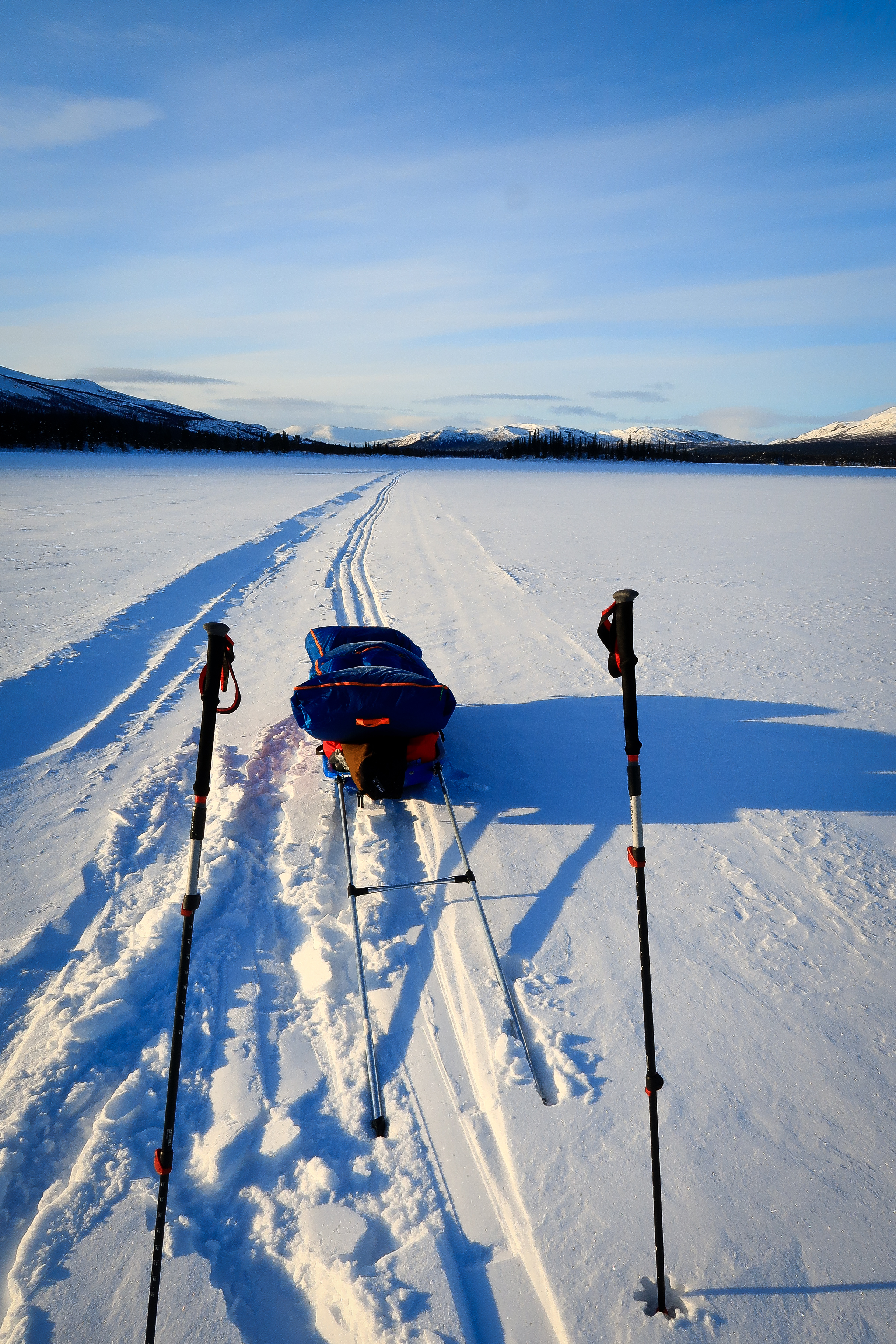
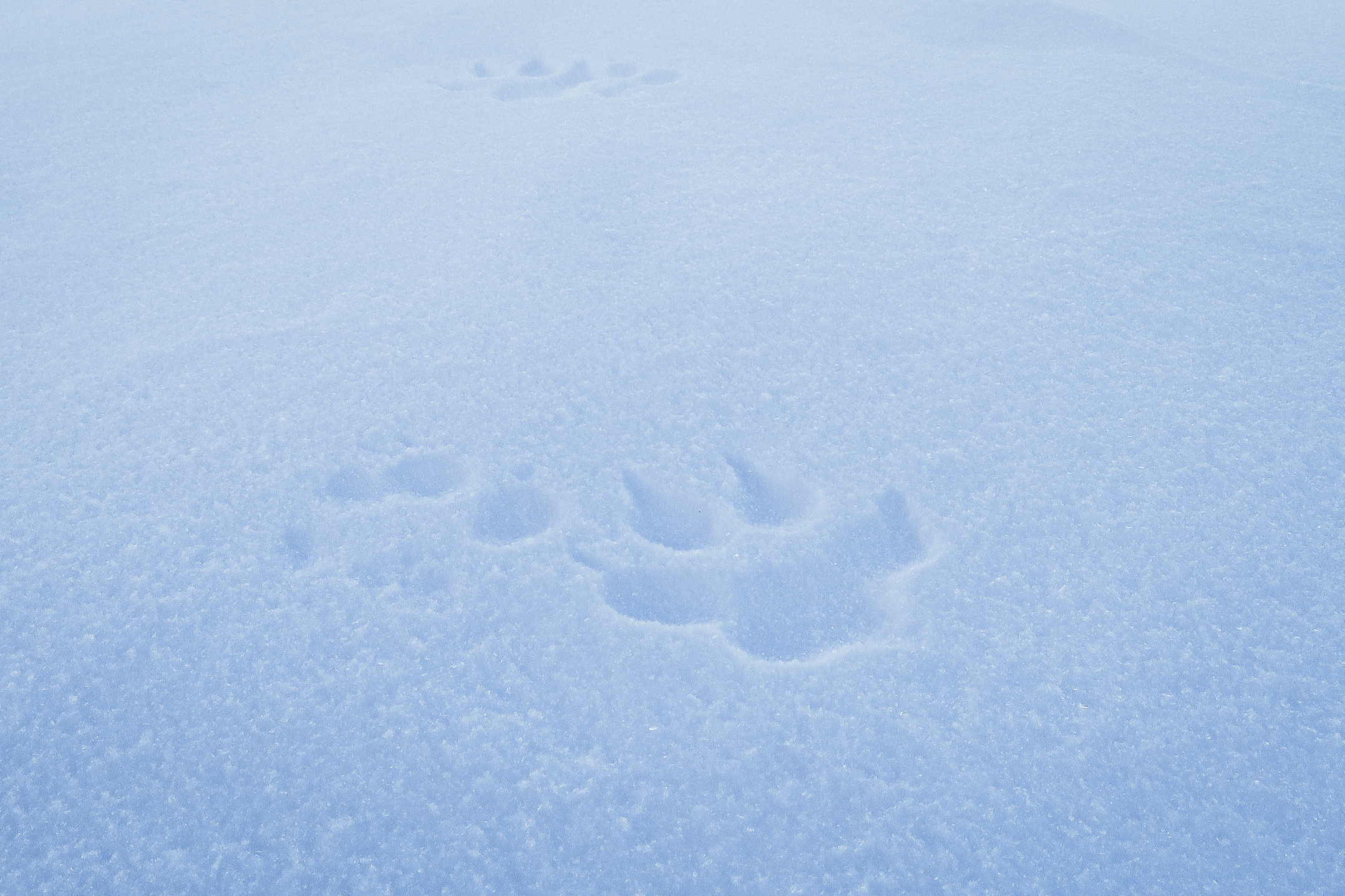
It should be of no surprise that less subtle signs of life belong to that famously destructive species which resides here; still surviving in brutal conditions, but with somewhat less elegance and harmony than the other animals with which is shares the locale. In one particular spot, along the track on which I travelled, was the burnt out remains of a snowmobile, plunged headfirst into the snowy hollow of an unfortunate sapling. I can only surmise as to whether the rider was simply distracted by the largely untouched beauty through which they drove, or just a younger chap, full of beans, and keen to show his apparent prowess to bemused friends. Either way, this particular misadventure had left its ugly scar on the landscape; a monument to civilised encroachment, lacking only an empty can of Red Bull, cast aside nearby, to complete the effect.
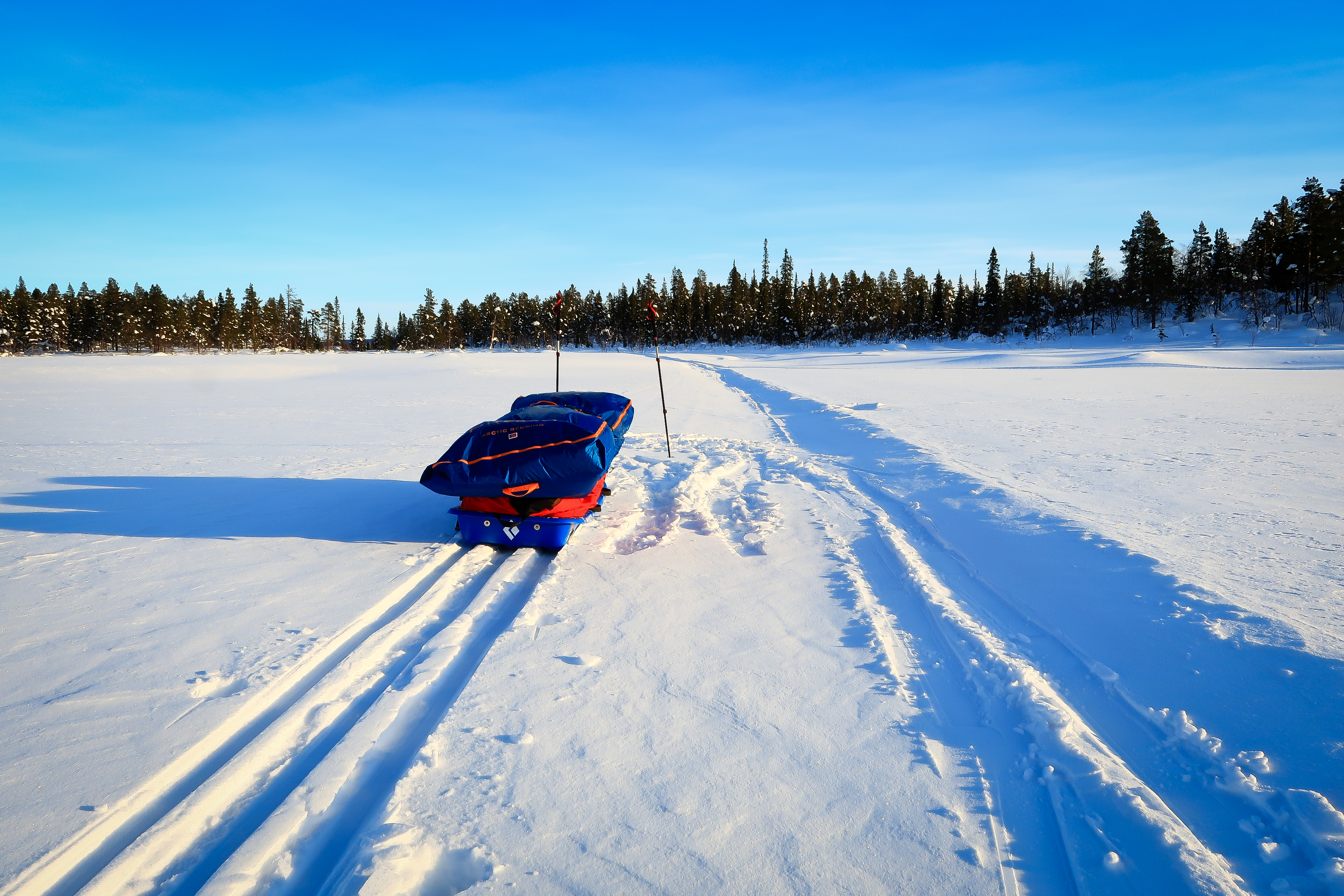
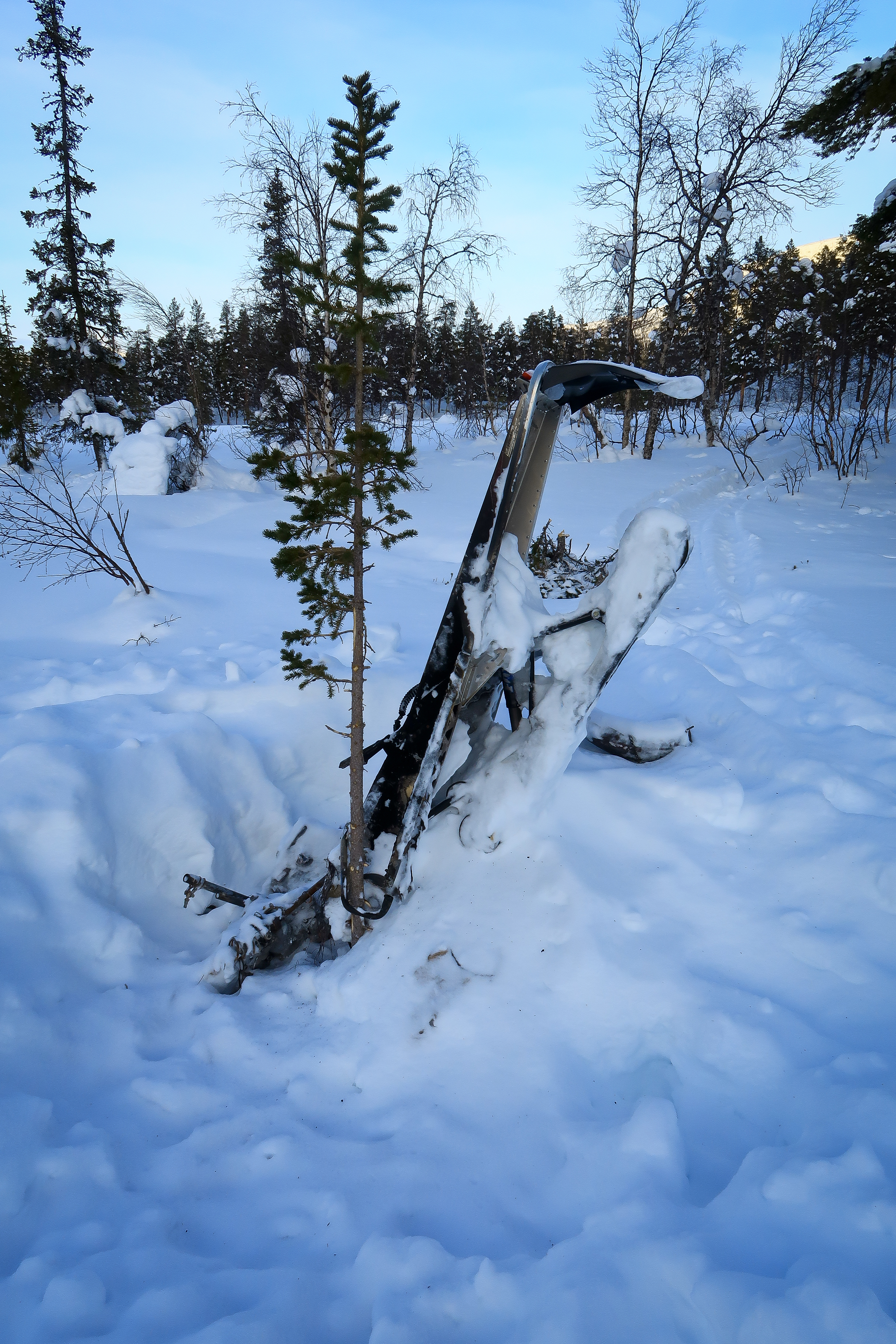
By the afternoon, my previously excellent progress of the morning had slowed considerably due to the snowmobile tracks petering out under a deep blanket of snow. While my wide downhill skis afforded me effective float, carving out such wide tracks in the snow was a little tiring and decidedly less efficient than on a long, thin Nordic ski. I had hoped to get close to 20km under my belt that day, and based on lunch time projections it would have certainly looked possible, however, the afternoon scuppered all chances. By the time I got to the edge of a large lake, which I would have to cross, I had travelled 15km and it was nearly an hour from sunset. With the uncomfortable plastic boots taking their toll on my feet, and a long lake crossing ahead of me, I decided to stop for the night and make use of the remaining daylight to make camp.
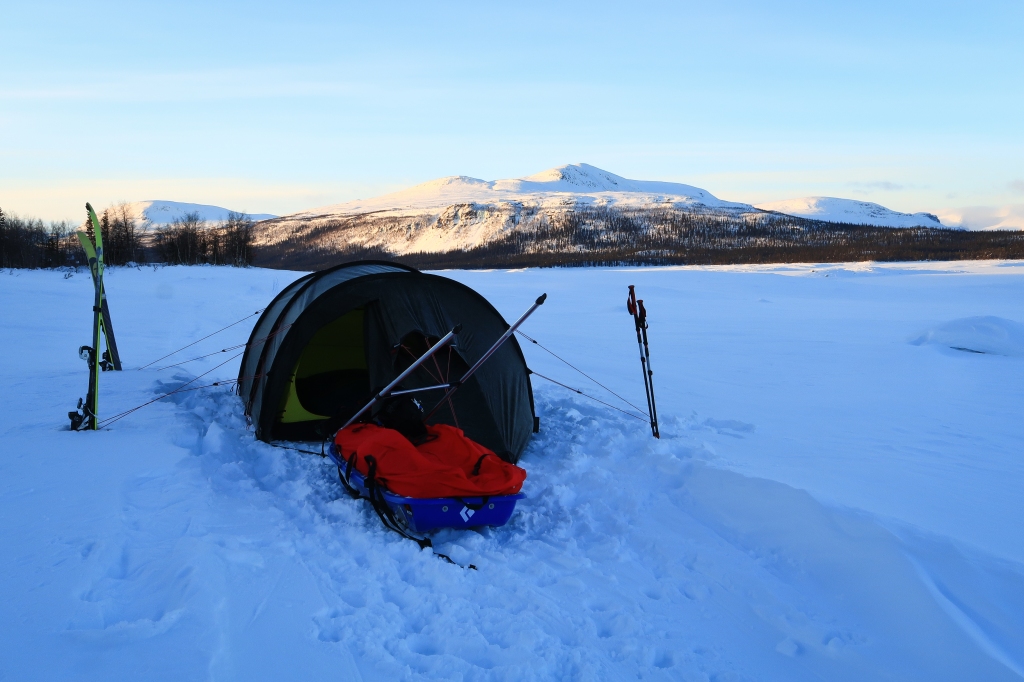
After pitching the tent, I crawled in to start the laborious process of melting snow to make the boiling water I needed for the evening’s dinner and tea. After firing up the stove, I look up to see a familiar face peering down at me. It was Paul; the friendly Swede from the previous day. For the first time I was able to catch a glimpse of his slightly dated, but no doubt reliable, pulk. It was a beautifully constructed wooden affair, varnished with the love of decades and topped with a modest bag. Upon his back was a huge olive-green canvas rucksack, a testament to his military days. We chatted for a little while before Paul told me of a couple of storms that were forecast in the next two days. The first would hit tonight from a WNW direction; hard to believe given that the air was so incredibly still at that point, and my satellite transmitted weather forecast showed no indication of any adverse weather. Though, given it had predicted -18oC on that fateful night where the thermometers all went off the scale, it was evident that weather forecasting here was more prophecy than science.’
“I look up to see a familiar face peering down at me“
As we chatted about the forecast I was orientating myself in my head; by a stroke of forethought I had orientated my tunnel shaped tent in the east-west direction based on my research prior to the trip that in the previous year, Sarek experienced more westerly winds than any other direction. My Hilleberg Keron 3, like other tunnel tents, is exceptionally strong along its major axis when pitched correctly; one of the reasons why it is very much the standard tent for Antarctic expeditions, albeit usually in red for visibility. However, if hit by the wind perpendicular, tunnel tents are a fair bit weaker and can exhibit significant flex, making for a more nervous slumber.
After our chat, Paul departed across the lake in the dwindling light, head torch at the ready as he aimed to make camp on the far side. After finishing my water boiling for the night I extracted myself from the tent and set to work with my snow shovel to build a snow wall a couple of metres in front of the tent to deflect the worst of the wind, while also piling snow around the bottom of the tent to prevent any wind getting under the flysheet. Not only can this blow snow into the tent, spoiling what little comfort there is, but in the worst case it can actually try and lift the tent off the ground, not that it would succeed with my hefty ballast present, but I certainly didn’t need any tent pegs pulled free. As I got to work shovelling snow, I was extremely glad of my Western Mountaineering down expedition boots. Sinking up to my waste in soft snow would have made for some incredibly cold and snow filled feet, if not for these fantastic knee-high boots keeping out the snow and ensuring my toes remained toasty throughout.
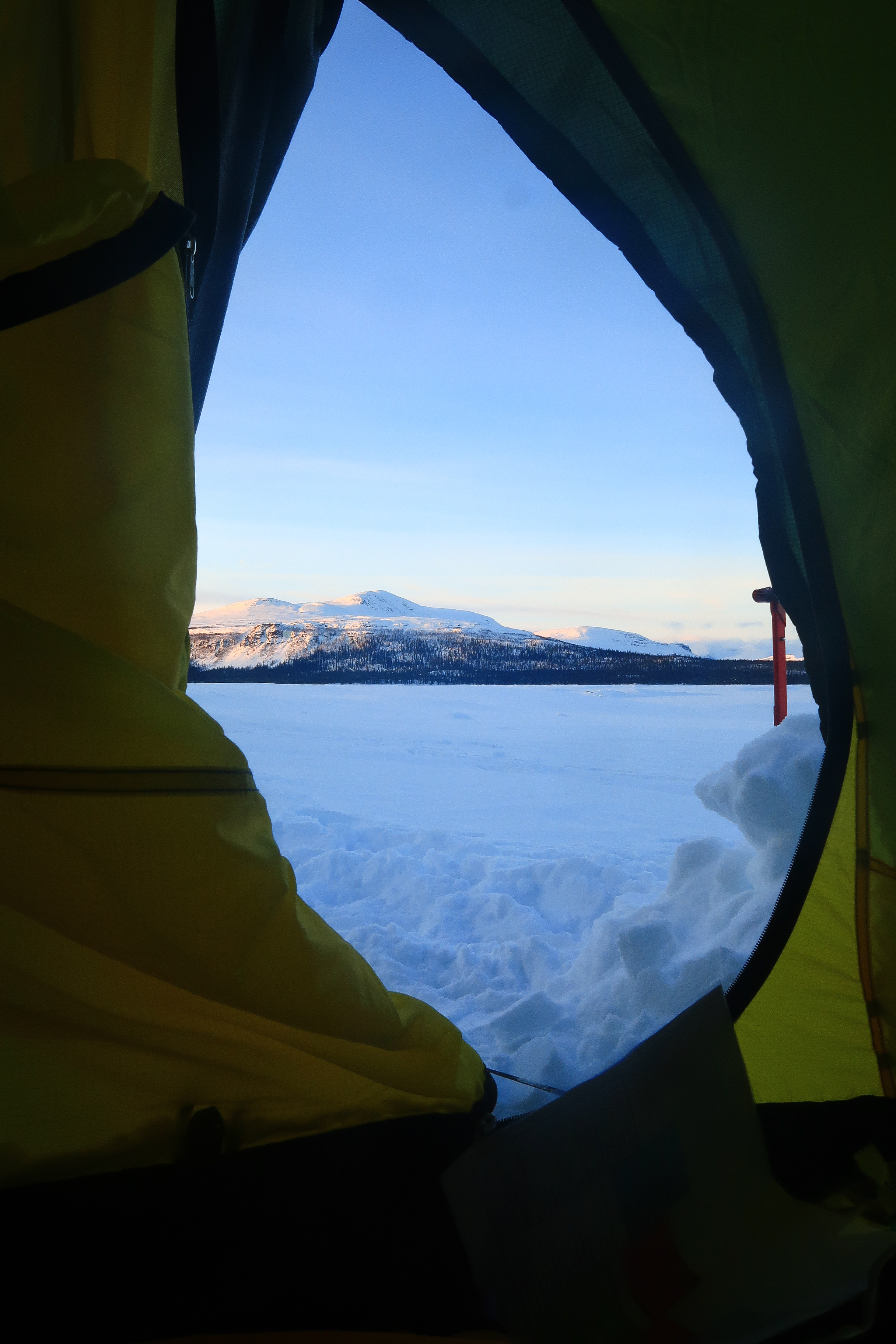
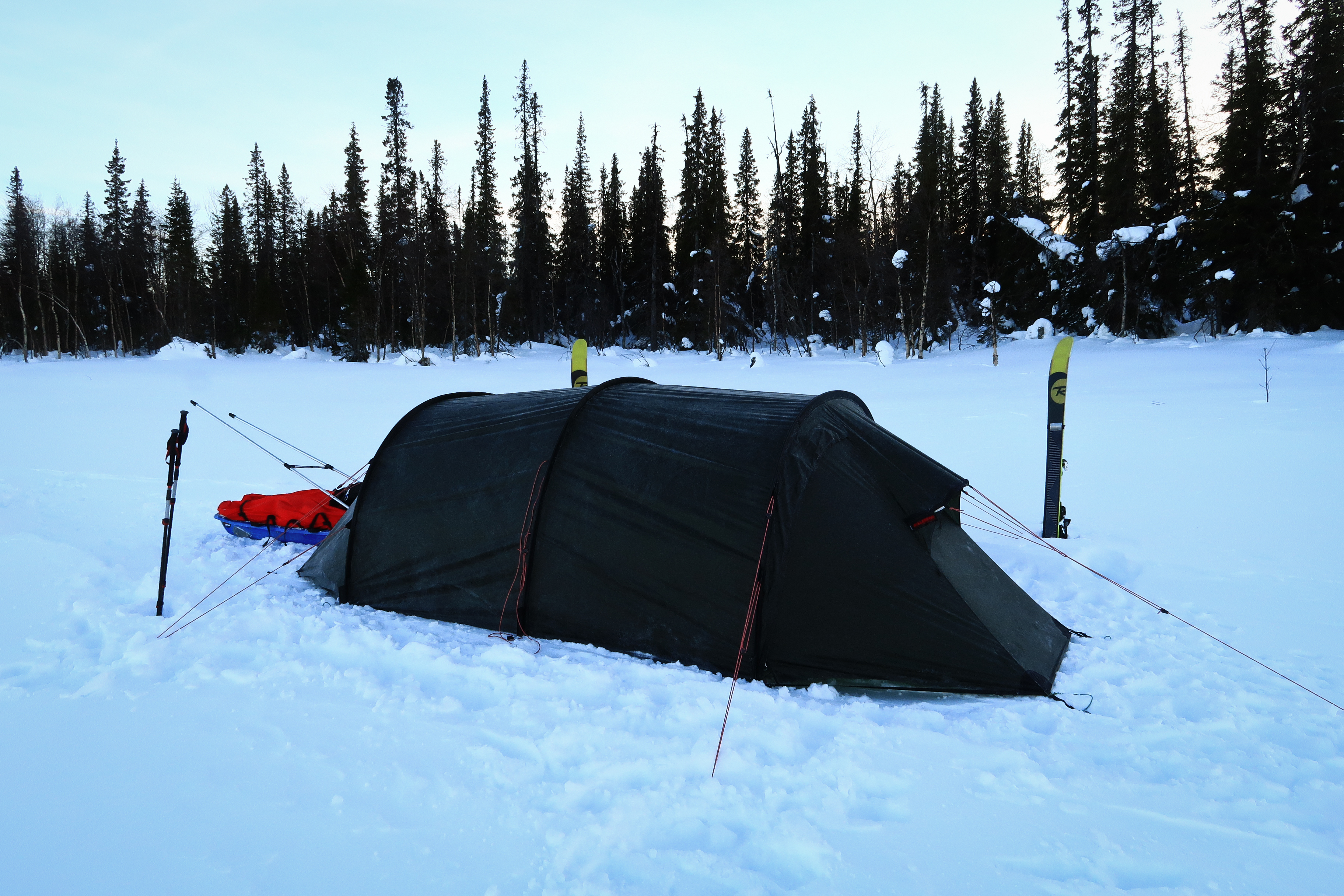
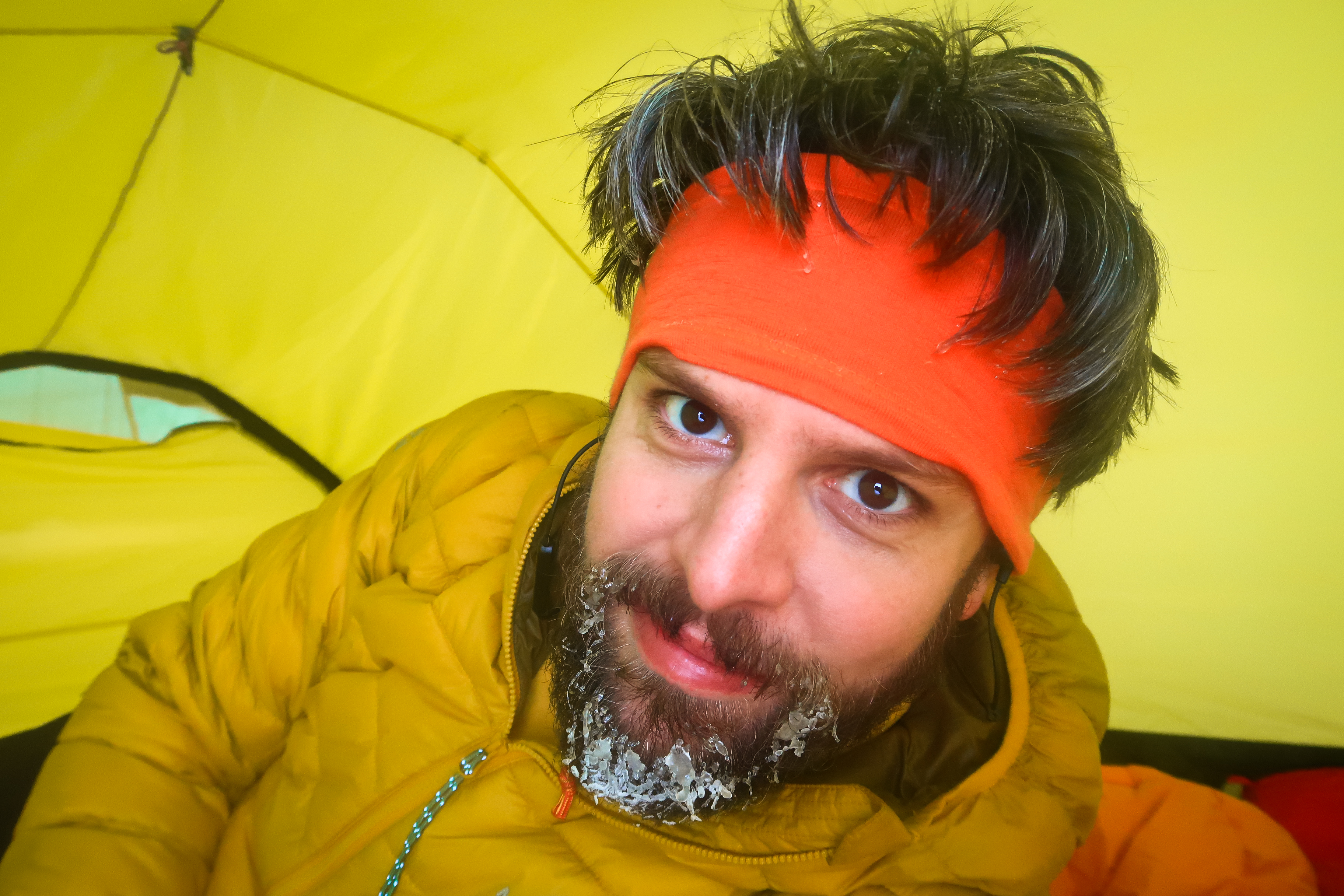
If you ever happen to see pictures of people building snow walls in places such as Antarctica, where they are often necessary, you’ll most likely observe a beautifully constructed wall made from geometrically cut blocks of hard snow. However, trying to replicate this with the deep, unconsolidated snow of Sarek was very much akin to trying to build a sand castle with dry sand; you just end up with an amorphous pile that resists any form which you might try and impart on it against its will. As such, my little snow wall was certainly not the sort of sculpture that one might like to show off at your local polar explorers club, but it was enough to assist the burly ‘HillePalace’ in fending off the as yet imperceptible storm.
As I settled down to sleep on yet another bitterly cold night with my snow flaps zipped up tight, I wondered where this storm had got to and whether it had taken a wrong turn in Norway. By midnight, my curiosity was very much laid to rest as I woke to violent shaking of the tent. While more than a match for any storm, even a tunnel tent with the reputation of a Keron 3 does tend to shake a little; it’s certainly not a quiet affair as it stands up to the bullying wind, ducking and diving like a nimble boxer avoiding the blows of its gargantuan opponent. Earplugs were able to drown out some of this fierce battle raging outside, but sleep alluded me that night for a different reason. As mentioned previously, all the condensation produced from one’s breath ends up turning into fine, snow-like frost structures on the inside wall of the tent. When this inner wall happens to be flapping about in a storm, however, that snow rains down in significant quantities. The tickling sensation from melting snow, on the exposed parts of my face that weren’t covered by my hat or sleeping bag, was sufficiently irritating to prevent me from sleeping the rest of that night.
“My curiosity was very much laid to rest as I woke to violent shaking of the tent”
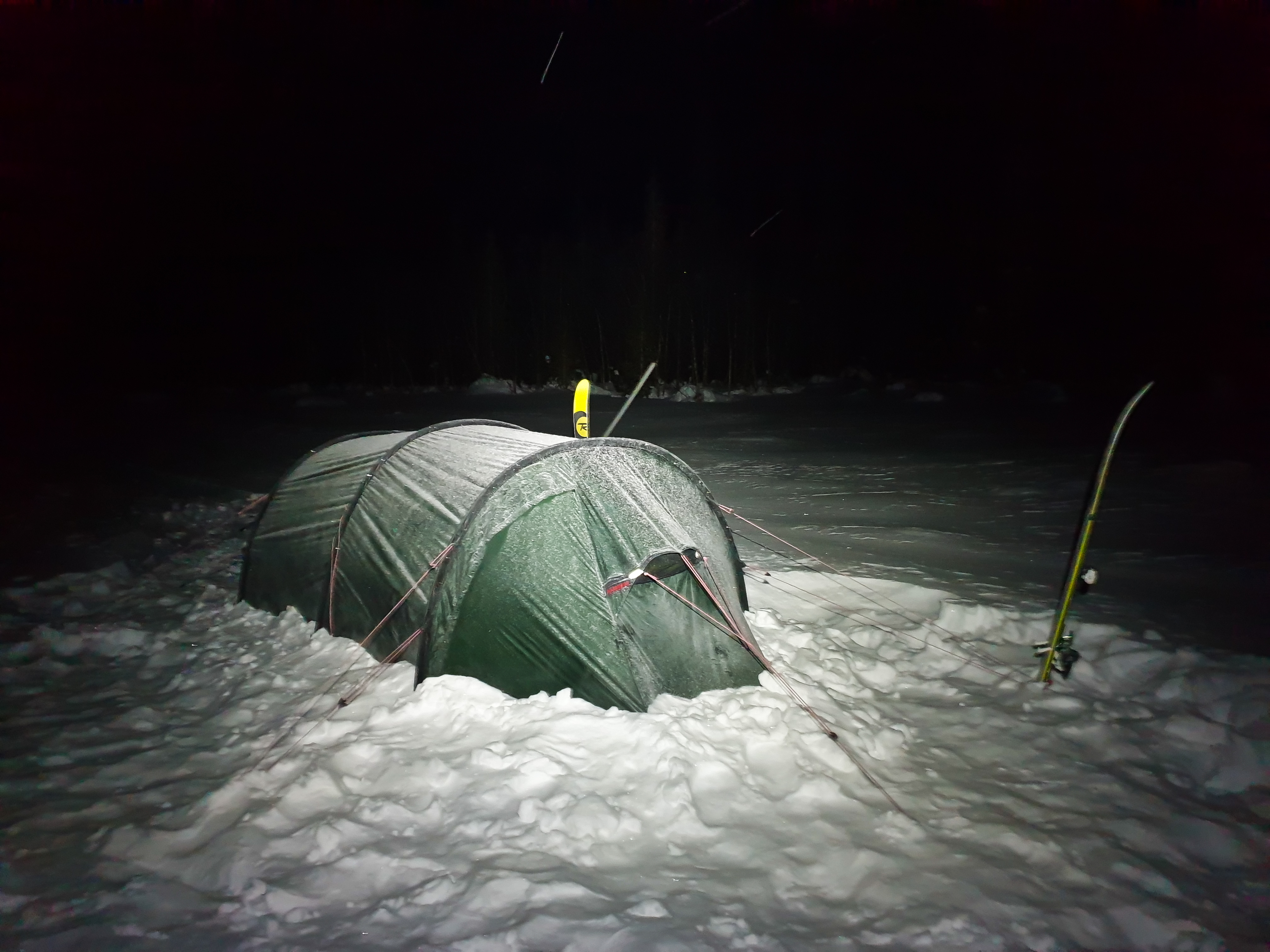
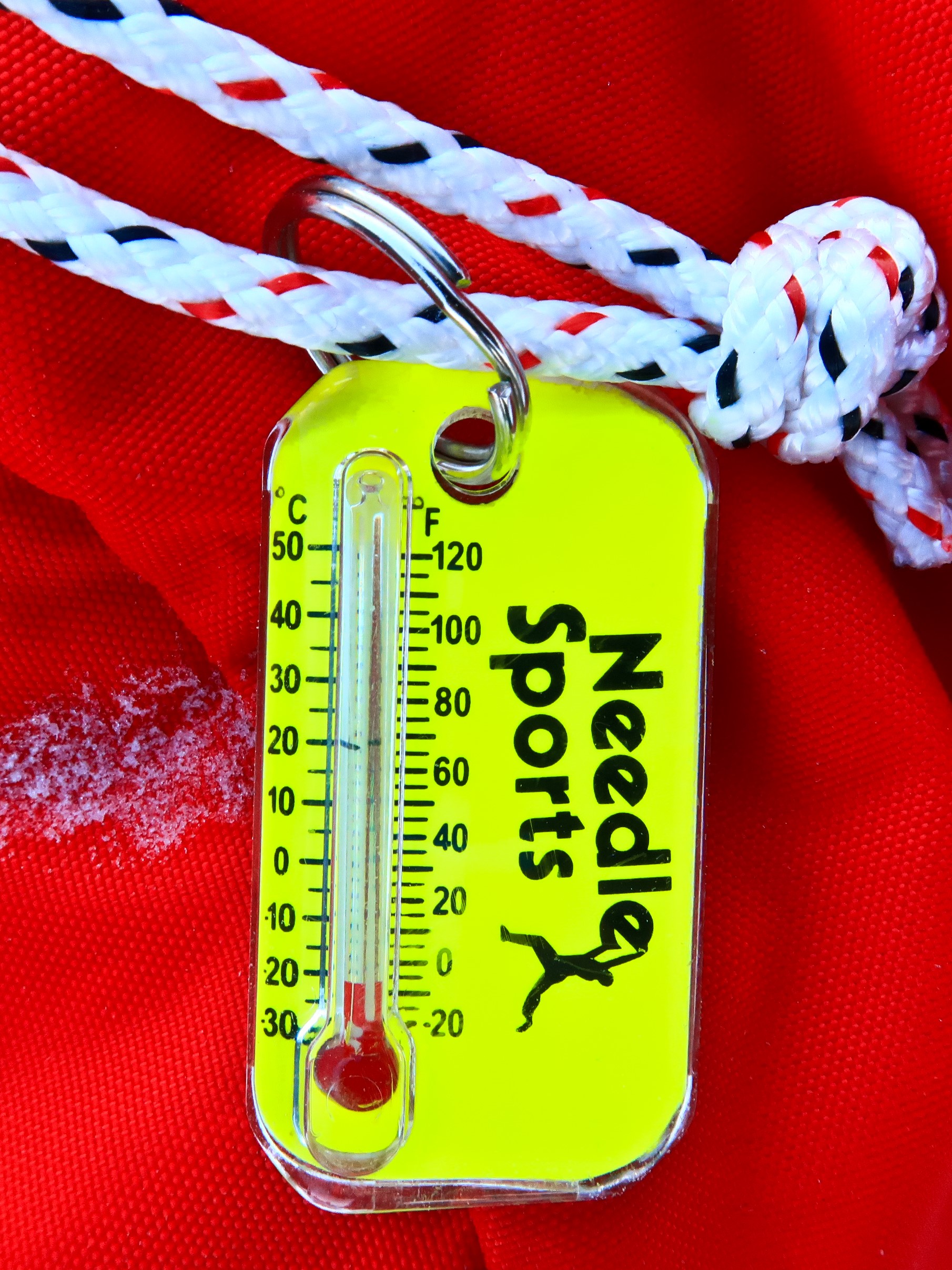
A Great Upheaval
The following morning was a great opportunity to expand my solo expedition skills by taking the tent down in the remnants of the storm which had raged through the night. Luckily, this is a reasonably straightforward affair with a tunnel tent, which is more than can be said for operating a stove on kerosene in the wind. Even on calm days I found myself arguing with the kerosene to persuade it to light, due in part to the wickedly low temperatures, but now in the wind it was a most trying exercise. Large flare ups during priming meant I had to move it out of the security of the tent porch, and like the hungover reveller on the morning after an over-indulgent shindig, I spent the entire time swearing that I’d never touch the stuff again. Blustery winds and uncooperative stoves meant that I set off uncomfortably late that morning; wearily I headed out across the expansive ice with my hood up and jacket well sealed.
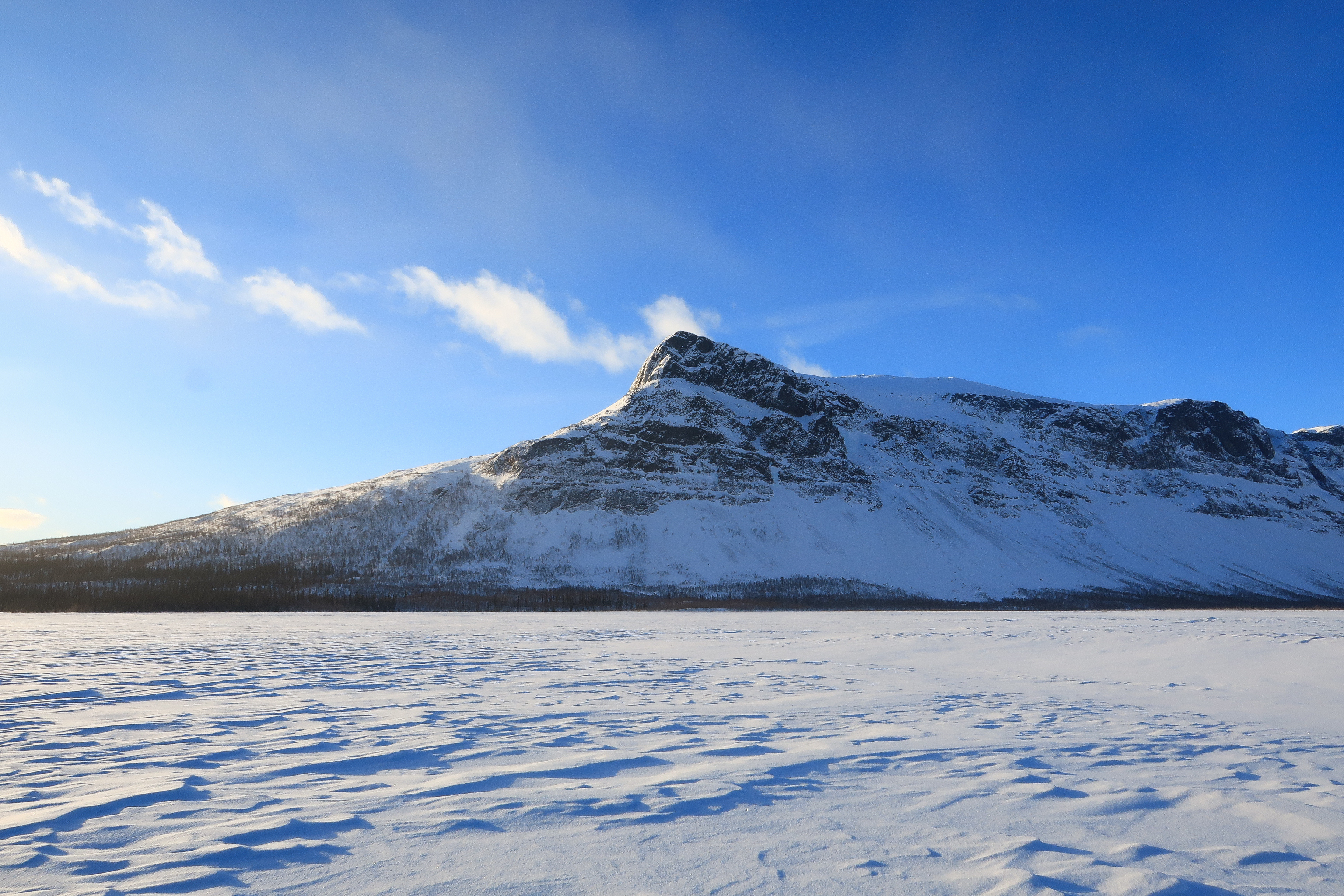
The first kilometres across the lake were a welcome change for my feet as they were totally numb so I was not experiencing the usual pain in my right foot as a result of my damn plastic boots. Sensibly, or not, the previous night I had left the snow flap slightly open on the rear vent to aid ventilation in a bid to reduce the quantity of frost which was being produced in my tent. The cunning wind had of course noticed this and spent the night piling in as much snow as possible into my waiting ski boots below. Difficult to remove entirely from a stiff plastic ski boot, it had caused my feet to become very cold that morning. However, all good things must come to an end, and when circulation is regained in a cold appendage, the feeling is not one which I would wish upon anyone else. Known affectionately as the ‘screaming barfies,’ or hot aches to be more technical, it is caused by lactic acid build up due to a lack of blood circulation. When circulation is regained, this lactic acid is reabsorbed in large quantities, and it’s not entirely fun.
“Known affectionately as the ‘screaming barfies’ “
Prior to the painful episode described above, I was able to enjoy some rather spectacular ice art on the north shore of the lake. As if created by some cataclysmic event, the foot-thick ice had been thrust up and fractured in spectacular ways, causing the landscape to look like that of an alien planet undergoing some strange upheaval. What caused this to happen only on the north side of the lake, while leaving the southern ice beautifully flat, I don’t know, but it certainly added a little spice to my route across the ice.
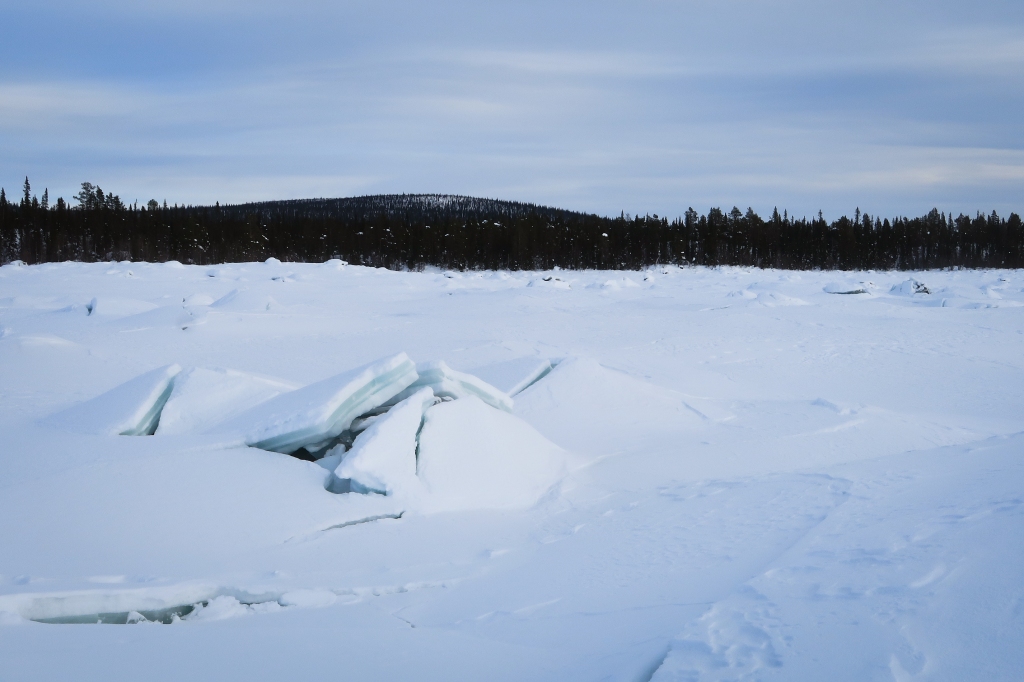
Safely across the lake, I climbed up through the woods following a vague track, my skins struggling for grip yet again. The blisters on my feet had reduced me to a mere shuffle up the hill, but after the crest I was rewarded for my efforts by some significant downhill sections. Although not remotely downhill by alpine standards, by now I was happy to take what I could get and with an unwieldy pulk in tow, it was quite enough. To save the hassle of locking down my heel, and then having to unlock again at each flatter section, I kept my ski bindings in ‘walk mode,’ which simply means they pivot at the toe. Wanting to avoid any intimate encounters between my face and the ground, as well as reducing the sticky friction of my kicker skins underfoot, I took the approach of leaning back into the skis. No doubt this is not the correct way to do it, but it certainly helped with avoiding a face plant, particularly with the pulk pushing forward from behind. This made for some interesting yet amusing skiing, and some rather ungraceful turns as I coaxed the whole ski-skier-pulk system around the trees.
Once at the bottom the long undulating hill, I came out into a small bay on the ice of the impressive Rapa river valley. I progressed further out onto the ice, until I passed the exit of the bay, my feet aching as I pushed myself for a few more kilometres that day. The towering peaks to the west were shielded from view, teasing me behind the persistent cloud. However, when I was halfway across, I looked west to find that the clouds had lifted to reveal their treasure below. Here, for the first time, I could catch a glimpse of the spectacular heart of Sarek…
Are you curious to learn how my adventure continued? You can subscribe to email notifications below and be informed as soon as a new post is published.
Other posts you might also be interested in
- Sarek Expedition – Part 1
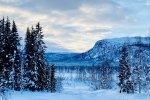 Armed with a sled, 60 earl grey tea bags, and 6 months of preparations, one gentleman decides to seek solitudeContinue reading “Sarek Expedition – Part 1”
Armed with a sled, 60 earl grey tea bags, and 6 months of preparations, one gentleman decides to seek solitudeContinue reading “Sarek Expedition – Part 1” - Sarek Expedition – Part 2
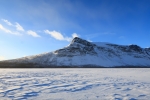 Battling frozen fuel, unpredictable storms and waist high snow; Arctic adventures can be trying at times. However, a British approachContinue reading “Sarek Expedition – Part 2”
Battling frozen fuel, unpredictable storms and waist high snow; Arctic adventures can be trying at times. However, a British approachContinue reading “Sarek Expedition – Part 2” - Sarek Expedition – Part 3
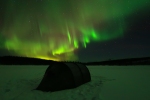 Sometimes things don’t go to plan… Not one bit. Even the most diligent preparation can end in tatters at theContinue reading “Sarek Expedition – Part 3”
Sometimes things don’t go to plan… Not one bit. Even the most diligent preparation can end in tatters at theContinue reading “Sarek Expedition – Part 3”
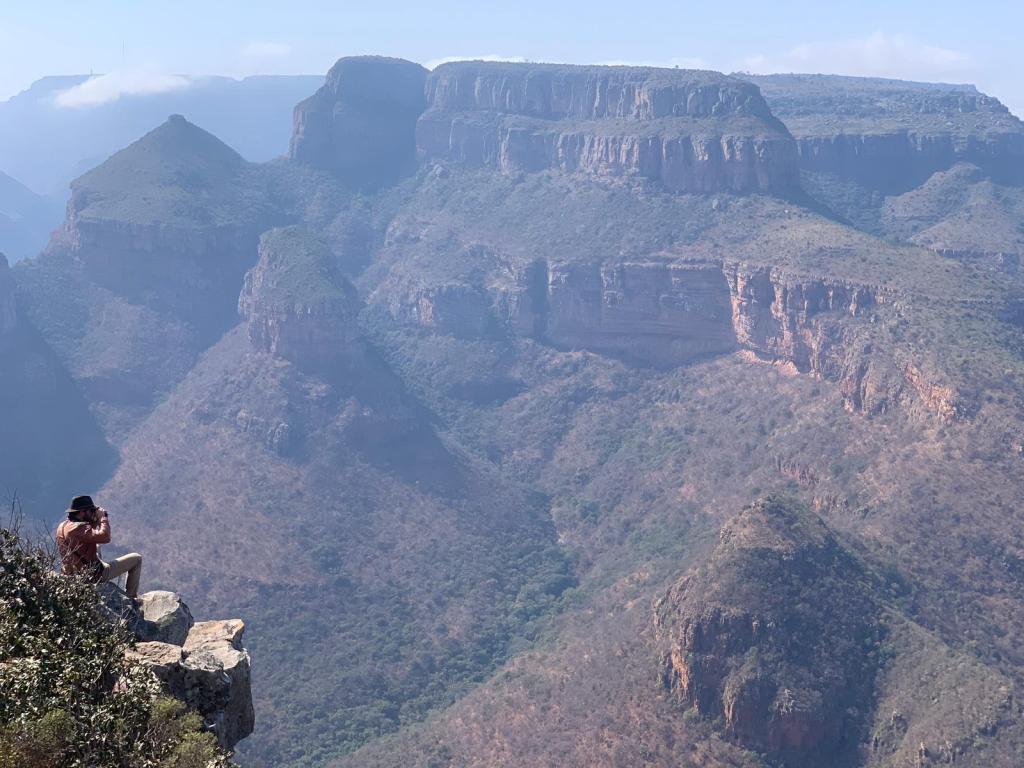
Want to stay updated on the latest adventures?
I have only just begun to tell the many stories of my adventures. Stay connected to learn about past, present and future expeditions.

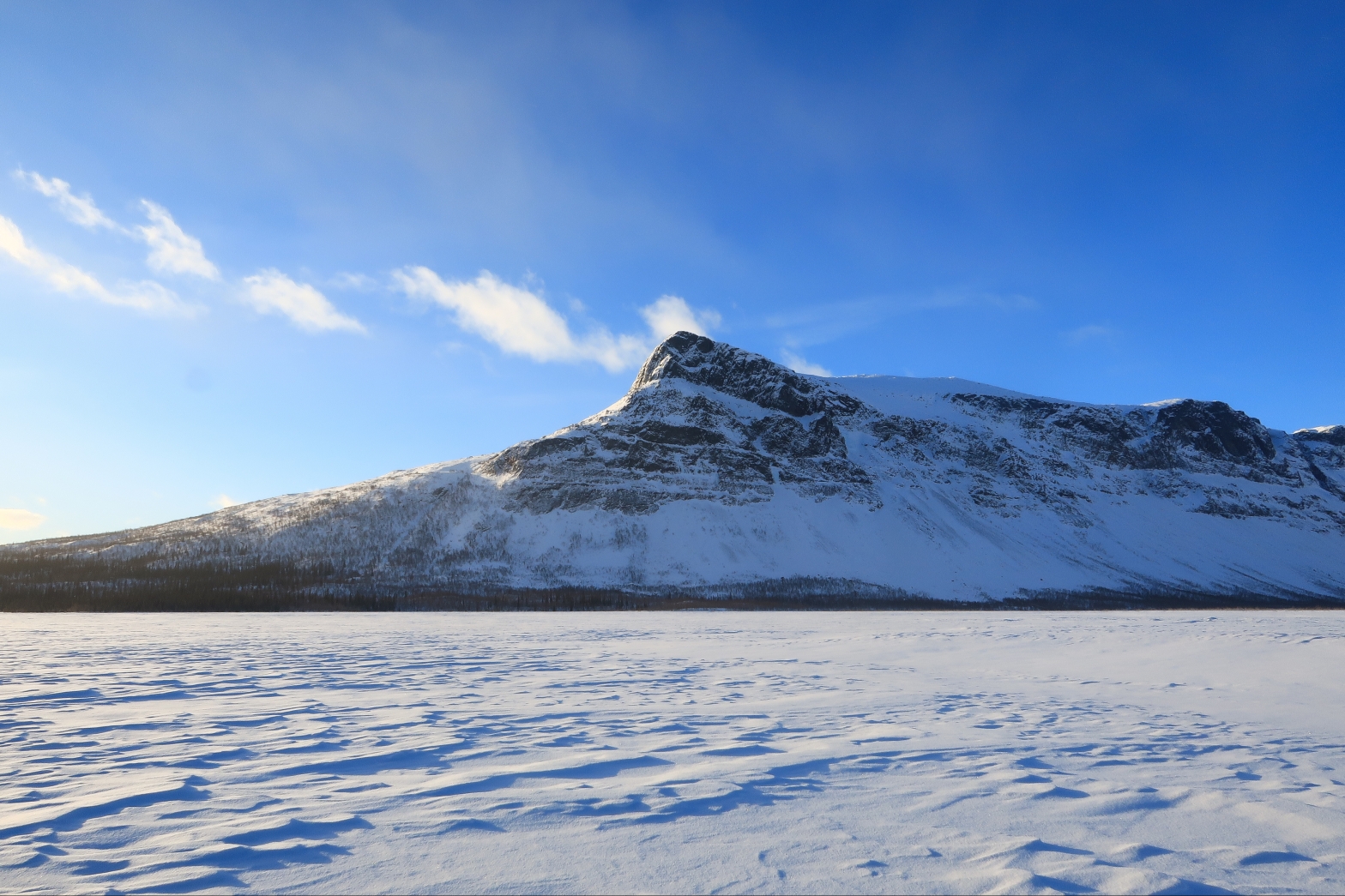
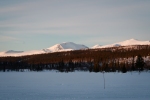
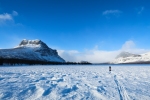
Love it,can’t wait for part 3.
Interesting writing !!
LikeLike
Great write up and some key learnings. Thanks for sharing.
LikeLike
Thank you both for your feedback. It is very much appreciated!
LikeLike
Enjoying the retelling of the adventure!
Question – is it against explorer rules to not pitch tents in a little camp at night. Seems a little odd, at least to me, that Paul did not stay around?
LikeLike
Both on solo trips (spoils the fun if you hang around others too much) and both with different routes/goals. Plus, in these temperatures, its too cold to sit around outside chatting!
LikeLike
Really enjoyed your story, looking forward to the next episode
LikeLike
Fascinating reading the details, after the updates; it’s the flesh on the bones of your adventure. Love your use of amusing similies too! Looking forward to part 3.
LikeLike
Great! Very interesting – thank you for sharing!
LikeLike